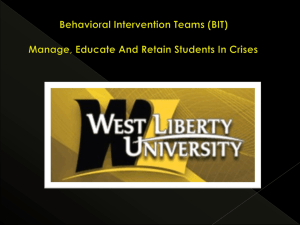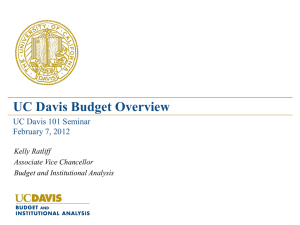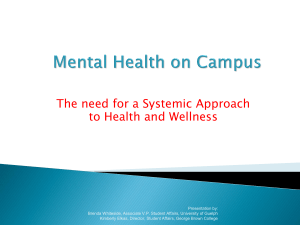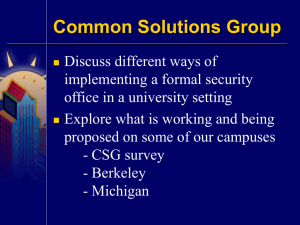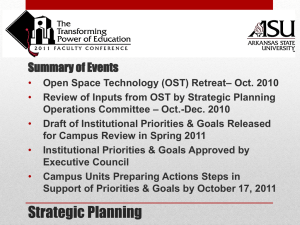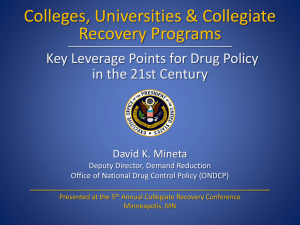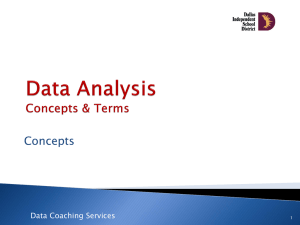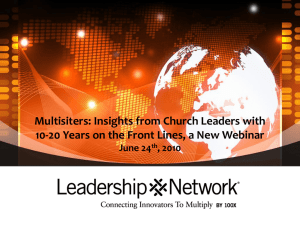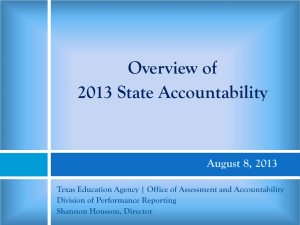CampusYAOverview_3 26 08
advertisement
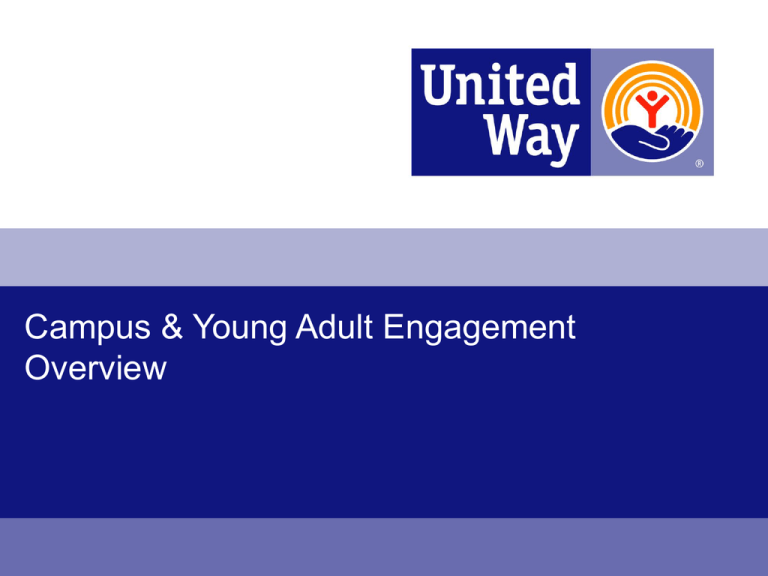
Campus & Young Adult Engagement Overview Campus & Young Adult Engagement Goals: • Help young adults (ages 18-24 years old) advance the common good on campus and in their communities • Help young adults grow as leaders • Develop an authentic, lasting relationship between young adults and the United Way movement 2 Advancing the Common Good by Focusing on Education, Income and Health Helping Children & Youth Achieve Their Potential Community Involvement Promoting Financial Stability & Independence Partnerships Public Policy Community Investment Improving People’s Health 2-1-1 Resource Generation Donor Relationships 3 Campus & Young Adult Engagement Today’s college and university students: • Represent a significant population of young adults in the USA • Succeed as volunteers and fundraisers, but can do even more with United Way help • Benefit from quality experiences volunteering, fundraising and with other pro-social activity • Differ from previous cohorts in important ways 4 Campus & Young Adult Engagement Population on campuses: • In 2005 there were over 29 million 18-24 year olds. • There were about 14 million undergraduate students in 2005. • Almost 46% of all 18-24 year olds had completed or were currently enrolled in higher education during 2006. US Census Bureau, www.census.gov, 2007. 5 Campus & Young Adult Engagement Students are successful volunteers and fundraisers: • In 2005, they volunteered approximately 132 million hours1 • They raised millions of dollars in 2006-2007 – Penn State Dance Marathon raised over $5 million – FSU Relay for Life raised over $135,000 • Existing resources on campus support their efforts – infrastructure, advising, funding, etc. • United Way can add community expertise and an impact perspective to their work 1 Corporation for National and Community Service, “College Students Helping America,” 2006. 2 Independent Sector, Value of Volunteer Time, independentsector.org, 2007. 6 Campus & Young Adult Engagement Positive effects on young adults: • On-campus volunteerism helps develop leadership, work skills, connection to community, pro-social attitudes, and more.1 • Students who volunteer are more likely to give to charities and continue volunteering later in life.2 Increasing the effect: • Offer opportunities to reduce the activation gap between young adults’ desire to be involved and their actual involvement levels. 1 Astin, Sax, and Avalos, “Long-term effects of volunteerism during the undergraduate years,” 1999. 2 Independent Sector, Giving and Volunteering in the United States, www.independentsector.org, 2007. 7 Campus & Young Adult Engagement Young adults in today’s world: • Communicate in new and fast-paced ways, and they have more access to more outlets for their prosocial activity than ever before • Are less aware of United Way, but agree more with United Way’s key principles than other cohorts • Are connecting with other major nonprofits through campus programs (Red Cross has more than 110 chapters; Habitat for Humanity even more) 8 Campus & Young Adult Engagement • Community Impact Generate time, talent, and resources for impact agenda; help youth achieve their potential • Branding and Marketing Expanded presence for United Way and partners on campuses and with a new market • Resource Development Short and long-term opportunities to engage students, campus, and community supporters • Talent Management Connection to United Way and partners as place for internships and employment 9 Campus & Young Adult Engagement Approaches to connecting with young people: • Inspire and be inspired by young adults • Engage young adults in community work in meaningful ways • Empower young adults to continue their engagement Along the way, United Way and partners will better understand, connect with, and support Gen Y 10 Campus & Young Adult Engagement United Way Students in Action – Pilot Project • Student-led community change organization on campus • Advised by local United Way and campus host • Educating, advocating, volunteering and fundraising • Special projects such as 10,000 Hours, ASB, and Trash to Treasure • Alumni network for long-term connections 11 United Way 10,000 Hours Show 12 United Way Students in Action Trash to Treasures What it is: • An end of the year collection of unwanted goods from college students • Goods are sold at minimal cost to community members Penn State University T2T 2007: • 6th PSU Trash to Treasure • 66 tons of items donated • $49,001 raised for Centre County United Way 13 United Way Alternative Spring Break • Engages young people ages 18-24 from campuses and the work place in United Way’s hurricane recovery work • In 2007, 320 young people participated • ¼ of participants became involved through their local UW • NCL employees participated • ASB 2007 generated 27,059.5 volunteer hours which credited $496,541.83 of Louisiana’s cost share to FEMA. • 84% of participants said they were more likely to volunteer in the future post-ASB 14 United Way Alternative Spring Break ASB Media: • On MTV’s Amazing Break • 213 broadcast stories, 29 print articles, and 20 online features • $315,000: Earned media value of UWA’s video news release • 8% increase on UW’s website • 14,000 visitors to the ASB Blog 15 Campus & Young Adult Engagement Advancing the common good now and into the future 16



